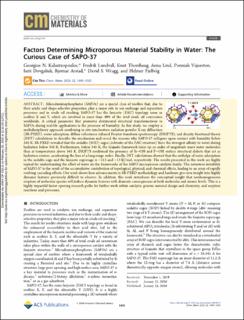| dc.contributor.author | Kalantzopoulos, Georgios N. | |
| dc.contributor.author | Lundvall, Fredrik | |
| dc.contributor.author | Thorshaug, Knut | |
| dc.contributor.author | Lind, Anna Maria | |
| dc.contributor.author | Vajeeston, Ponniah | |
| dc.contributor.author | Dovgaliuk, Iurii | |
| dc.contributor.author | Arstad, Bjørnar | |
| dc.contributor.author | Wragg, David | |
| dc.contributor.author | Fjellvåg, Helmer | |
| dc.date.accessioned | 2020-10-19T11:33:54Z | |
| dc.date.available | 2020-10-19T11:33:54Z | |
| dc.date.created | 2020-02-27T16:25:37Z | |
| dc.date.issued | 2020 | |
| dc.identifier.citation | Chemistry of Materials. 2020, 32 (4), 1495-1505. | en_US |
| dc.identifier.issn | 0897-4756 | |
| dc.identifier.uri | https://hdl.handle.net/11250/2683627 | |
| dc.description.abstract | Silicoaluminophosphates (SAPOs) are a special class of zeolites that, due to their acidic and shape-selective properties, play a major role in ion exchange and separation processes and in crude oil cracking. SAPO-37 has the faujasite (FAU) topology same as zeolites X and Y, which are involved in more than 40% of the total crude oil conversion worldwide. A critical parameter that promotes detrimental structural transformations in SAPOs during real-life applications is the presence of humidity. In this study, we employ a multidisciplinary approach combining in situ synchrotron radiation powder X-ray diffraction (SR-PXRD), water adsorption, diffuse reflectance infrared Fourier transform spectroscopy (DRIFTS), and density functional theory (DFT) calculations to describe the mechanism and reveal the reasons why SAPO-37 collapses upon contact with humidity below 345 K. SR-PXRD revealed that the sodalite (SOD) cages (subunits of the FAU structure) have the strongest affinity to water during hydration below 345 K. Furthermore, below 345 K, the faujasite framework takes up an order of magnitude more water molecules than at temperatures above 345 K. DRIFTS confirmed the presence of Si−OH and P−OH surface structural defects that act as hydration centers, accelerating the loss of a long-range order. Finally, DFT calculations showed that the enthalpy of water adsorption in the sodalite cage and the faujasite supercage is −212 and −13 kJ/mol, respectively. The results presented in this work are highly topical for understanding the effect of water on the frameworks of the SAPO microporous catalysts family. The notorious instability of SAPO-37 is the result of the accumulative contribution of topological, physical, and chemical effects, leading to an array of rapidly evolving cascading effects. Our work shows how advancements in SR-PXRD methodology and hardware give new insight into highly dynamic features previously difficult to observe. In addition, this work introduces the conceptual insight that nonhomogeneous sorption of molecular species will induce dynamic features with dramatic consequences at both molecular and atomic levels. This is a highly impactful factor opening research paths for further work within catalysis, porous material design and chemistry, and sorption reactions and processes. | en_US |
| dc.language.iso | eng | en_US |
| dc.publisher | ACS Publishing | en_US |
| dc.rights | Navngivelse 4.0 Internasjonal | * |
| dc.rights.uri | http://creativecommons.org/licenses/by/4.0/deed.no | * |
| dc.subject | Microporous Material | en_US |
| dc.subject | Silicoaluminophosphates | en_US |
| dc.subject | Separation processes | en_US |
| dc.subject | Crude oil cracking | en_US |
| dc.subject | SAPO | en_US |
| dc.title | Factors Determining Microporous Material Stability in Water: The Curious Case of SAPO-37 | en_US |
| dc.type | Peer reviewed | en_US |
| dc.type | Journal article | en_US |
| dc.description.version | publishedVersion | en_US |
| dc.rights.holder | © 2020 American Chemical Society | en_US |
| dc.source.pagenumber | 1495-1505 | en_US |
| dc.source.volume | 32 | en_US |
| dc.source.journal | Chemistry of Materials | en_US |
| dc.source.issue | 4 | en_US |
| dc.identifier.doi | 10.1021/acs.chemmater.9b04510 | |
| dc.identifier.cristin | 1798212 | |
| dc.relation.project | Norges forskningsråd: 233848 | en_US |
| dc.relation.project | Norges forskningsråd: 208896 | en_US |
| dc.relation.project | Interreg: 190980 | en_US |
| dc.relation.project | Notur/NorStore: NN2875K | en_US |
| dc.relation.project | Notur/NorStore: NS2875K | en_US |
| cristin.unitcode | 7401,80,64,0 | |
| cristin.unitcode | 7401,80,40,0 | |
| cristin.unitname | Materialer og nanoteknologi | |
| cristin.unitname | Prosessteknologi | |
| cristin.ispublished | true | |
| cristin.fulltext | original | |
| cristin.qualitycode | 2 | |

